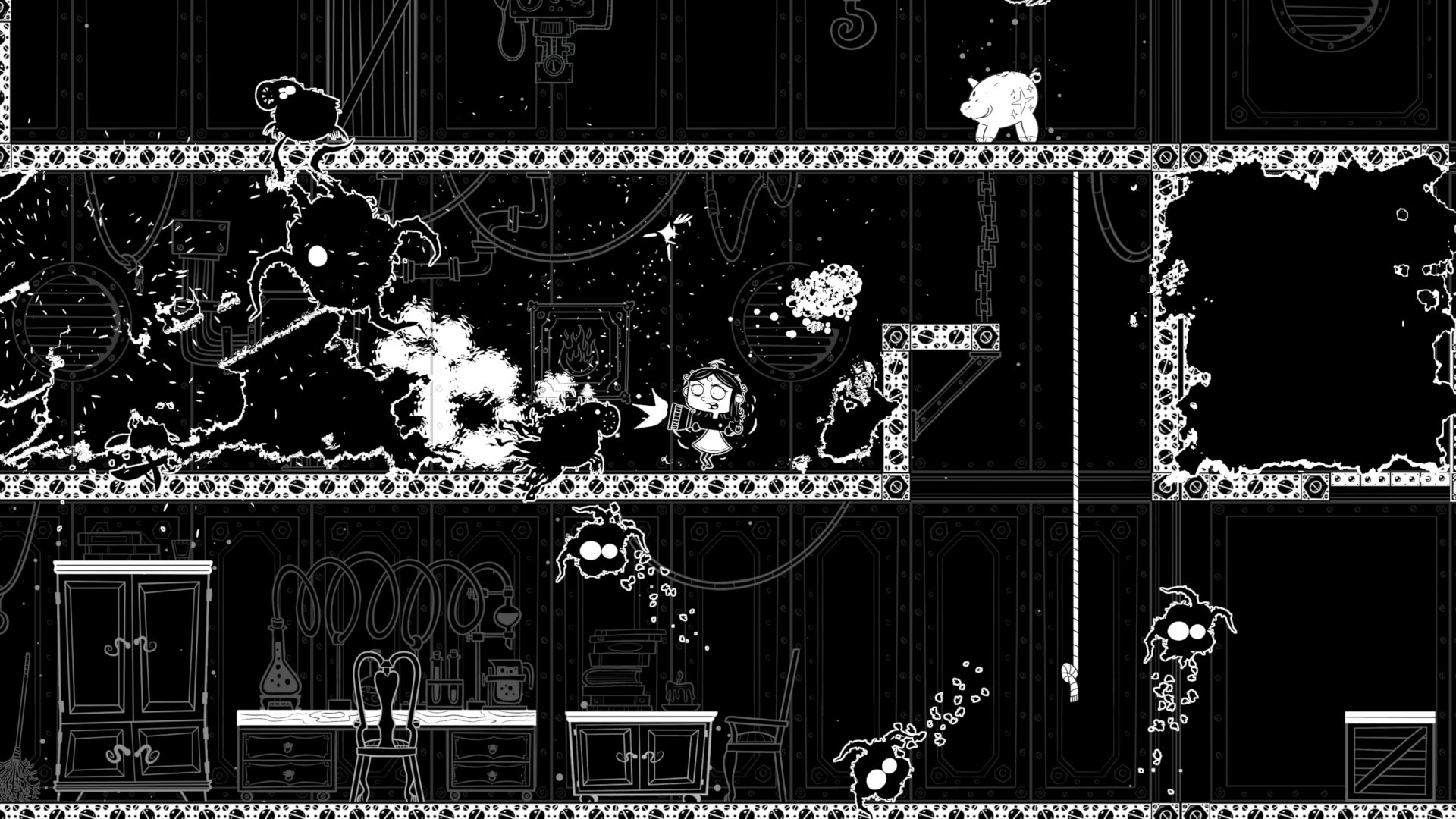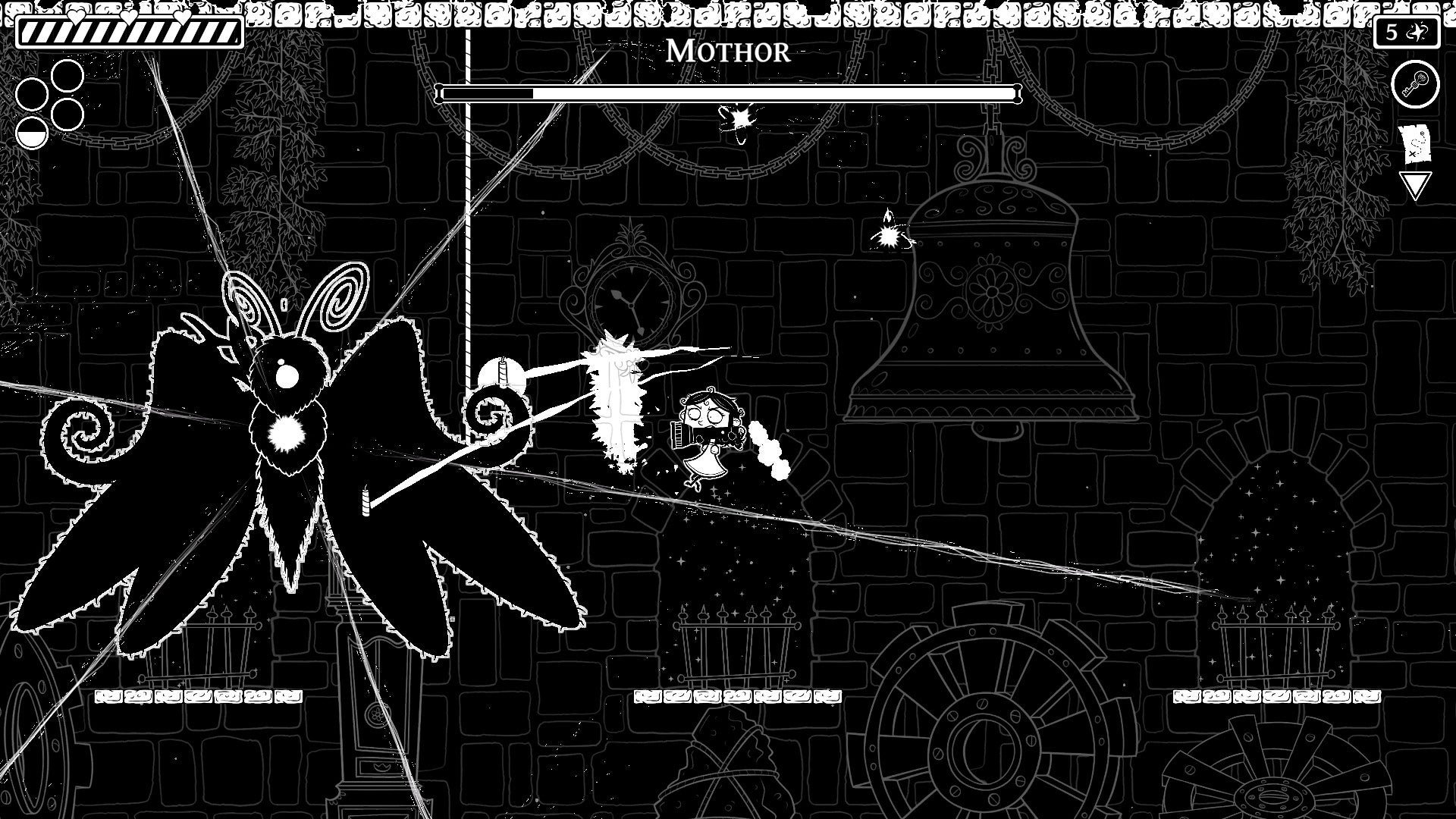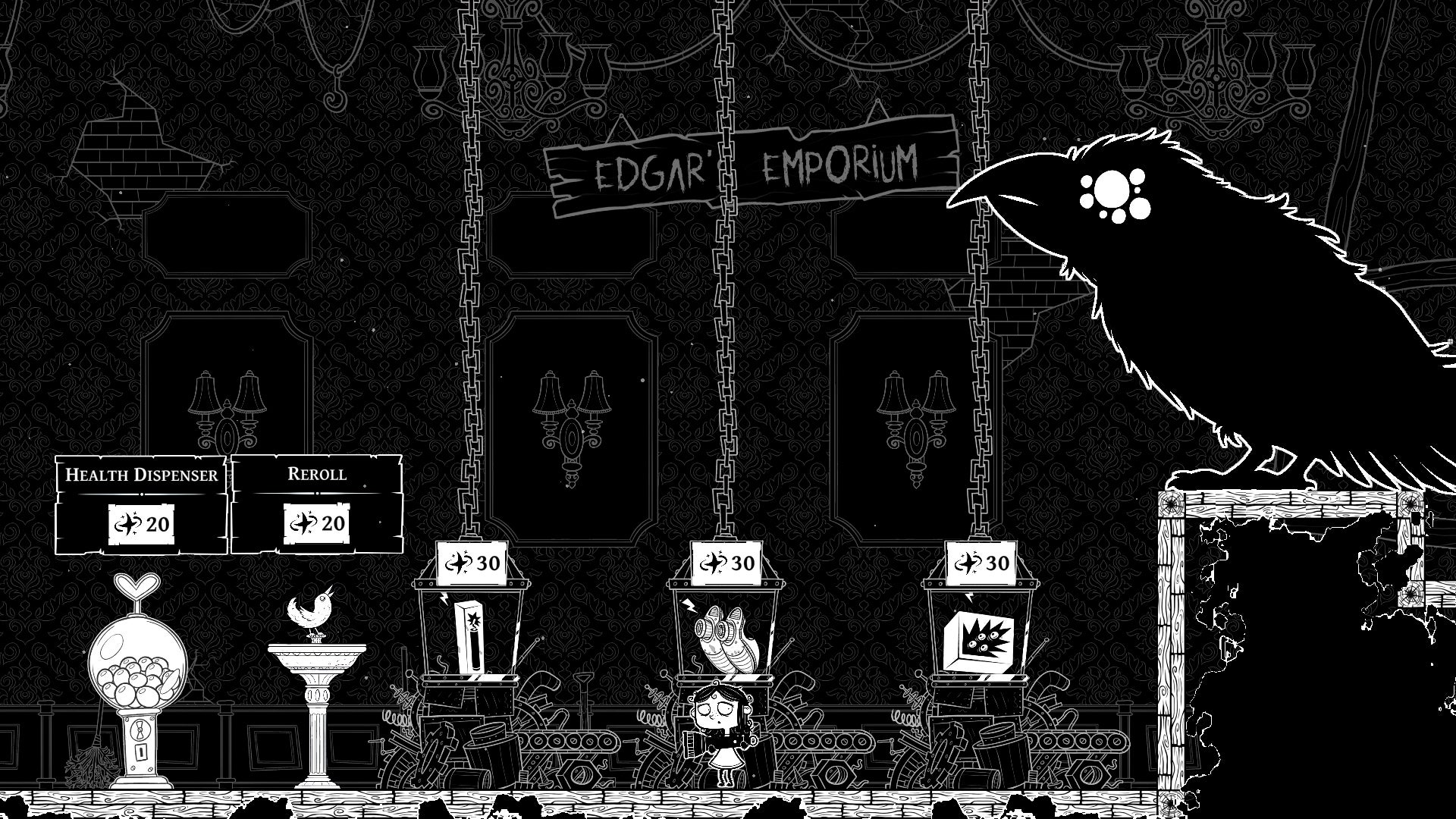Eyes in the Dark is a side-scrolling roguelike that uses twin-stick controls (keyboard is also supported, but I wouldn’t recommend it), features a manor of nine zones that are procedurally generated per each attempt, and utilises a powerful, customisable flashlight as its main tool. It’s a title that is designed to be replayed for years to come, and it’s one that I almost certainly will continue to pick up long after this review is published.
Meet Victoria Bloom. Victoria is revealed to be the youngest from a long family tree made up of scientists and tinkerers, and you’ll first see her as she travels to visit her grandpa at the beloved family mansion of Bloom Manor. It’s all very Belmont, right?
Upon arrival at the house, however, it soon becomes apparent that Bloom Manor is rampant with monsters – and only Victoria is available to put a stop to them. She will not rest until she defeats every Guardian across the mansion and is reunited with her dear grandpa at long last. And there are so many secrets to uncover along the way, all obscured by the darkness.
The first thing that’ll catch anyone’s attention when it comes to Eyes in the Dark is the environmental design; the realm of Bloom Manor is strictly monochrome and carefully illustrated, and you don’t get to see every crevice of the mansion without a little work.
Bloom Manor’s levels are initially shrouded in darkness, a fog so thick that plenty of critters are hiding away in it. Using your flashlight – the main gimmick for this game – you can gradually dispel the dark and reveal your surroundings to take a closer look, or finish off that spider that keeps chasing you.
‘Light combat’ and having players clear the environment of darkness also demands that players focus on their environment, and for good reason; it’s so easy to miss something good. The darkness can conceal chests, trapdoors, and, sometimes, even the black background that you seemingly cannot interact with will hide a secret or two. That wardrobe you keep jumping atop? You can actually open it for a reward. And the secrets simply don’t stop there: not only is the monochrome manor incredibly nice to look at, but engaging too. Binding of Isaac, eat your heart out.
The flashlight in Eyes in the Dark is an interesting primary mechanic. While Victoria can bravely run through the darkness to clear the murk away, it is unsafe to do so – there’s no telling what lurks in the dark, after all! The flashlight can be used to clear the darkness, combat enemies, and collect Sparks, a currency that can be used to purchase further modifications for items. It can be aimed 360 degrees for perfect enemy tracking, and if you want to refill your slingshot with ammo, it all boils down to slaying enemies with your torch. This sounds cool, right? A torch in a game that isn’t completely redundant? That’s rare, if you ask me, so consider me sold. Take notes, Mr. Wake.
In this mesmerising mansion full of creepy crawlies, the flashlight feels like your only friend. There are so many unique modifications to try, ranging from electricity bulbs that will attack multiple enemies with a chain of energy, to items that’ll add burn damage or shoot water at foes. Certain batteries can improve your range of attack, and so forth. There are so many ways in which your items can be modified over time, it’ll make every run feel unique (and worthwhile). This, paired with procedurally generated zones, means that no two turns about this haunted house are ever the same.
On top of that, enemies across Eyes in the Dark add more depth and texture to each run thanks to the specific challenges they impart. Some bugs will fly at you relentlessly, so it’s up to you to hide and peek to fire at them. On the other hand, other bugs will be shunned away by light, so fighting with them requires acting a little slower, and being more thoughtful. Spiders that can’t jump very far, beetles stay along one platform, and many other critters that I simply couldn’t identify do other things that’ll force you to rethink the way you play. What about the leeches and mosquitoes, for example? How are they going to mess you up?
As you navigate the ever-changing Bloom Manor, you’ll become accustomed to the critters squatting there, and will find yourself studying their every move so that you know how to prepare. The strategic planning required for those more difficult, later battles is particularly gruelling; Eyes in the Dark may look cute, but it isn’t easy. So you’re not going to want to neglect your dodge functions – which temporarily render you immune to damage. This simple ability definitely pulled me out of a pinch on more than one occasion.
Boss fights do not feel too far removed from a level in Super Mario Bros. either, weirdly. As you traverse a zone and clear the endemic critters out, you’ll soon end up locked in a single room with a big monster to deal with. As you try to quash them with both your torch and slingshot, there’ll often be a handful of minions to deal with – and a chest or two (if you’re lucky). Beyond this, you’ll be hopping around avoiding incoming projectiles just as Mario would, trying to land shots on the deadly foe. The only differences would be the monochrome environment, and the fact you’re trying to rescue your grandpa from these monsters, and not Princess Peach.
Combat is incredibly satisfying, throughout your experience. The fulfilling gameplay feels even more rewarding as you round up Sparks and retrieve Knowledge that can then be used for items to make you even more powerful for your next run, or to simply make the next run different. It’s up to you, and it makes you feel in charge of your fate (to a degree, at least).
Eyes in the Dark is also privy to inspiration from some literary greats – H.P. Lovecraft and Edgar Allan Poe – and the references to the work of these authors establishes a real gloomy, gothic mood across the manor. If you’re up for Tim Burton via Hades, you’re going to be all over this.
In fact, as you traverse the zones as Victoria and fight with light against the darkness, it almost feels like you’re playing out a Lovecraftian tale. This is only reinforced when you first meet Edgar, the raven merchant who collects and sells shiny wares. Not only does this raven share a name with America’s favourite anti-transcendentalist, but their existence as a bird of misfortune is so clearly modelled off Poe’s famous poem, The Raven.
With this being a game about a mansion shrouded in darkness, these subtle (and not-so-subtle) references to classic gothic literature become a core part of the whole experience. However, you may also notice subtle similarities to Limbo, Metal Slug, and even Cartoon Network classic, Samurai Jack. The latter may seem odd, but game director Vladimir Bogdanic shared this a while back in an interview with ShackNews. When you really analyse these titles, it’s quite amazing to see how deeply implanted the developer’s inspirations are – while keeping the game itself incredibly fresh in a world of never-ending roguelikes.
Eyes in the Dark offers a whole range of replayability in this sense, given that your items and their modifications can dramatically change how gameplay goes down. In addition, the manor’s nine zones can also be played and replayed in any order as they amp up in difficulty. You can start in the garden and end in the foyer, vice versa, and you can plan what order to visit each zone in depending on how much trouble they gave you, which is a nice touch for spicing up gameplay. It’s something that sets the game apart from its genre stablemates, too.
For those who fall in love with Eyes in the Dark, and I suspect there’ll be many, there’s a huge avenue of endless fun and exploration here that feels incredibly fresh, and honestly, flawless. The darkness always hides away more secrets, and who knows what chest you might’ve missed last time around? Spurred on by mysteries like these – as well as the mystery of Bloom Manor, and just how satisfying playing as Victoria is – you’ll undoubedtly want to keep playing for hours. And hours. And hours.
Eyes in the Dark will reward the most brave and adventurous of players with more trinkets and Sparks, and ultimately, Victoria Bloom might even be able to reclaim the manor and rescue her grandpa at long last. Not this run, at least. However, I doubt it’s long before you start all over again to see if you can blast through Bloom Manor even quicker, or even more efficiently. And that’s the wonder and amazement of a combination of a whimsical environment, unique creatures, and a super-powered customisable flashlight.
Eyes in the Dark is a real testament to the efforts and inspirations of developer, Under the Stairs, and after this experience with Bloom Manor, I truly look forward to seeing what it’s capable of next.



